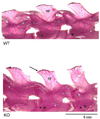Myostatin (GDF-8) as a key factor linking muscle mass and bone structure
- PMID: 20190380
- PMCID: PMC3753581
Myostatin (GDF-8) as a key factor linking muscle mass and bone structure
Abstract
Myostatin (GDF-8) is a member of the transforming growth factor-beta (TGF-beta) superfamily that is highly expressed in skeletal muscle, and myostatin loss-of-function leads to doubling of skeletal muscle mass. Myostatin-deficient mice have been used as a model for studying muscle-bone interactions, and here we review the skeletal phenotype associated with altered myostatin signaling. It is now known that myostatin is a key regulator of mesenchymal stem cell proliferation and differentiation, and mice lacking the myostatin gene show decreased body fat and a generalized increase in bone density and strength. The increase in bone density is observed in most anatomical regions, including the limbs, spine, and jaw, and myostatin inhibitors have been observed to significantly increase bone formation. Myostatin is also expressed in the early phases of fracture healing, and myostatin deficiency leads to increased fracture callus size and strength. Together, these data suggest that myostatin has direct effects on the proliferation and differentiation of osteoprogenitor cells, and that myostatin antagonists and inhibitors are likely to enhance both muscle mass and bone strength.
Figures





References
-
- McPherron AC, Lawler AM, Lee SJ. Regulation of skeletal muscle mass in mice by a new TGF-beta superfamily member. Nature. 1997 May 1;387(6628):83–90. - PubMed
-
- Lee SJ. Regulation of muscle mass by myostatin. Annu Rev Cell Dev Biol. 2004;20:61–86. - PubMed
-
- Schuelke M, Wagner KR, Stolz LE, Hubner C, Riebel T, Komen W, et al. Myostatin mutation associated with gross muscle hypertrophy in a child. N Engl J Med. 2004 Jun 24;350(26):2682–2688. - PubMed
-
- Tsuchida K. Activins, myostatin and related TGF-beta family members as novel therapeutic targets for endocrine, metabolic and immune disorders. Curr Drug Targets Immune Endocr Metabol Disord. 2004 Jun;4(2):157–166. - PubMed
Publication types
MeSH terms
Substances
Grants and funding
LinkOut - more resources
Full Text Sources
Other Literature Sources
Miscellaneous
